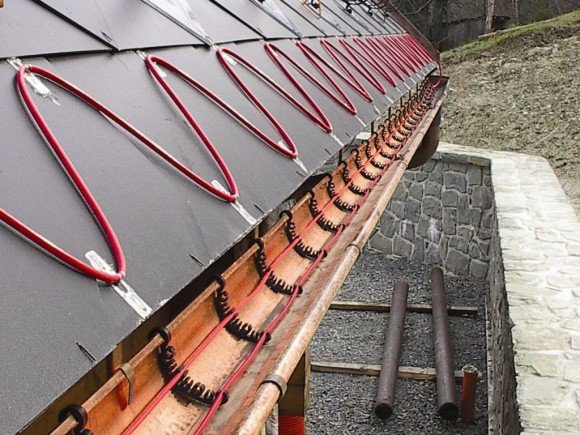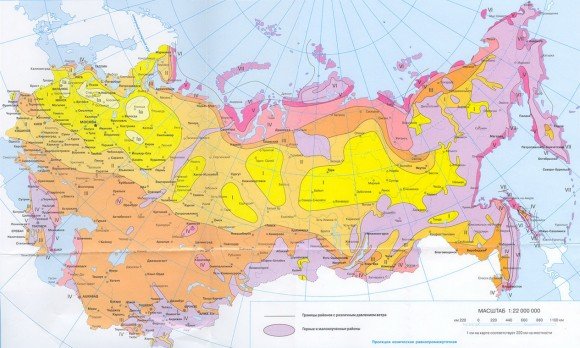When designing a roof, it is necessary to take into account the loads acting on it - snow and wind. To determine the indicators of these values, you can contact a special construction organization, where engineers will help you with the calculations. But if you want to do everything yourself and do not doubt your strength, then here you will find the necessary formulas with a detailed description of the quantities that will be needed in the calculation. So, to begin with, we will understand what these loads are and why they must be taken into account.
The Russian climate is very diverse. It is important to understand that the change in temperature, wind pressure, precipitation and other physical and mechanical factors will influence the roof of a house under construction. Moreover, the degree of their influence will directly depend on the area of construction. All this will put pressure not only on the roof enclosure - the roof, but also on the supporting structures, such as rafters and crates. It must be understood that the house is a single structure. According to a chain reaction, the load from the roof is transferred to the walls, and from them to the foundation. Therefore, it is important to calculate everything to the smallest detail.
Content
Snow load
The snow cover that forms in the winter on the roof of the house exerts a certain pressure on it. The north the area, the more snow. It seems that the risk of breakdowns is higher, but you should be more careful when designing a house in an area where there is a periodic change in temperature, which can cause snow melting and its subsequent freezing. The average weight of snow is 100 kg / m3, but in the wet state it can reach 300 kg / m3. In such cases, the snow mass can cause deformation of the rafter system, hydro and thermal insulation, which will lead to leakage of the roof. Such weather conditions will affect the rapid and uneven descent of snow from the roof, which can be dangerous for humans.
The greater the slope of the roof, the less snow deposits on it will be delayed. But if your roof has a complex shape, then at the junction of the roof, where internal corners are formed, snow may collect, which will contribute to the formation of an uneven load. It is better to install snow retainers in areas where the amount of precipitation is large enough so that snow collected near the edge of the cornice cannot damage the drainage system. Snow can be cleaned independently, but this process cannot be called absolutely safe.
In order to ensure safe snow flow and prevent the formation of icicles, a cable heating system is used. It can be controlled automatically or manually. Depends on your desire and choice. Heating elements of such a system are located along the entire edge of the roof in front of the gutter.
For Russia, the snow load value will depend on the construction area. To determine how much snow cover will be in your area, a special map will help.
The technology for calculating the snow load: S = Sg * m, where Sg is the estimated value of the snow cover weight per 1 m2 of the horizontal surface of the earth, taken according to the table, and m is the coefficient of transition from the weight of the snow cover of the earth to the snow load on the cover.
The estimated snow cover weight Sg is taken depending on the snow region of the Russian Federation.
Determination of snow load
The coefficient m depends on the angle of inclination of the slope of the roof, with the angles of inclination of the slope of the roof:
-
less than 25 degrees m equal to 1
-
from 25 to 60 degrees, the value of m is taken equal to 0.7 (approximately, for each slope its own value)
-
more than 60 degrees, the value of m, in the calculation of the total snow load, is not taken into account.
Wind load
The wind exerts lateral pressure on the walls of the house and the roof. Colliding with an obstacle, the air flow is distributed, going down to the foundation and up into the eaves of the roof. If you do not calculate the wind pressure, then the roofing can simply disrupt from the hurricane wind. Such destruction can not always be fixed by some cosmetic repair, often this leads to the need to replace the roof. An important indicator when calculating the impact of wind take into account the aerodynamic coefficient. It depends on the angle of the roof. The steeper the ramp, the greater the load, and the wind will try to “knock over” the roof. If the angle of your roof is small, then the wind will act on the roof like a lifting force, trying to tear it and carry it away. In order to prevent this from happening, you need to properly observe the design of the roof. The stability of the rafter system depends on providing spatial rigidity, which consists of the correct combination of braces, braces and diagonal ties in it, as well as their rigid attachment to each other. In addition, the wind can carry objects that, in a collision with the roof, will leave mechanical damage. To avoid this, you need to carefully choose the roofing and properly organize the crate for its installation.
The wind pressure, as well as the weight of the snow cover, will depend on the area of construction. Zoning can be determined by the map below.
Wind Calculation Technology
The coefficient k, taking into account the change in wind pressure with height z, is determined by the table below, depending on the type of terrain. The following terrain types are accepted:
-
A - open coasts of the seas, lakes and reservoirs, deserts, steppes, forest-steppes, tundra;
-
B - urban areas, forests and other areas evenly covered with obstacles more than 10 m high;
-
C - urban areas with buildings with a height of more than 25 m.
A structure is considered to be located in a terrain of this type if this terrain is maintained on the windward side of the structure at a distance of 30h - with a building height of h up to 60 m and 2 km. - at a higher height.
| Height z, m | K coefficient for terrain types | ||
|---|---|---|---|
| ≤ 5 | 0,75 | 0,50 | 0,40 |
| 10 | 1,00 | 0,65 | 0,40 |
| 20 | 1,25 | 0,85 | 0,55 |
| 40 | 1,50 | 1,10 | 0,80 |
| 60 | 1,70 | 1,30 | 1,00 |
| 80 | 1,85 | 1,45 | 1,15 |
| 100 | 2,00 | 1,60 | 1,25 |
| 150 | 2,25 | 1,90 | 1,55 |
| 200 | 2,45 | 2,10 | 1,80 |
| 250 | 2,65 | 2,30 | 2,00 |
| 300 | 2,75 | 2,50 | 2,20 |
| 350 | 2,75 | 2,75 | 2,35 |
| ≥ 480 | 2,75 | 2,75 | 2,75 |
Note: when determining the wind load, the terrain types may be different for different design wind directions.
Wind and snow loads when designing canopies
Particular attention should be paid to the calculation of those who are thinking about designing a canopy - for example, for a gazebo or parking a car. Usually in such cases an economical construction is used that does not have sufficient rigidity. Therefore, snow pressure cannot be ignored. It is recommended to clean the snow on time, preventing the formation of snow cover more than 30 cm thick. For a canopy made of wood, it will be more reliable to make a continuous crate and reinforced rafters. If you chose a metal structure, then it should have an appropriate profile thickness. In any case, to select materials of the necessary stiffness, it is better to use the calculation results.
Examples of calculation of snow and wind loads for Moscow and the Moscow region
Example No. 1: Calculation of snow load
Initial data:
-
region: Moscow
-
roof pitch: 35 degrees
Find the full calculated value of the snow load S:
-
the full estimated value of the snow load is determined by the formula: S = Sg * m
-
on the map of snow cover zones of the territory of the Russian Federation, we determine the number of the snow region for Moscow: in our case, this is III, which corresponds to the table with the weight of the snow cover Sg = 180 (kgf / m2);
-
the transition coefficient from the weight of the snow cover of the earth to the snow load of the coating for a roof angle of 35 degrees m = 0.7
-
we get: S = Sg * m = 180 * 0.7 = 126 (kgf / m2)
Example No. 2: Calculation of the wind load
Initial data:
-
region: Moscow
-
roof pitch: 35 degrees
-
building height: 20 meters
-
type of terrain: urban areas
Find the full estimated value of the wind load W:
-
The calculated value of the average component of the wind load at a height z above the surface of the earth is determined by the formula: W = Wo * k,
-
According to the map of wind pressure zones across the territory of the Russian Federation, we determine region I for Moscow
-
The standard value of the wind load corresponding to the I region is taken Wo = 23 (kgf / m2)
-
The coefficient k, taking into account the change in wind pressure with height z, is determined by the table. 6 k = 0.85
-
We get: W = Wo * k = 23 * 0.85 = 19.55 (kgf / m2)








Ingener k.t.n.
The load is calculated incorrectly 🙂 Only Tatars consider the load 🙂
John
reasoned answer Ingener k.t.n. Thanks ))